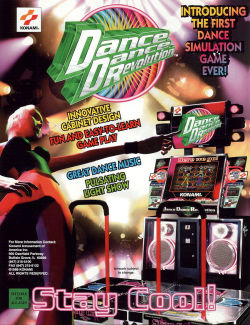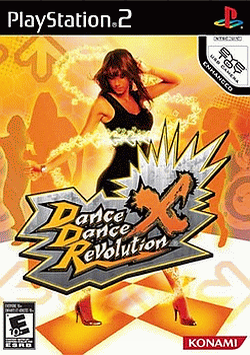Dance Dance Revolution (DDR) is a music video game series produced by Konami. Introduced in Japan in 1998 as part of the Bemani series, and released in North America and Europe in 1999, Dance Dance Revolution is the pioneering series of the rhythm and dance genre in video games. Players stand on a "dance platform" or stage and hit colored arrows laid out in a cross with their feet to musical and visual cues. Players are judged by how well they time their dance to the patterns presented to them and are allowed to choose more music to play to if they receive a passing score.

StepMania is a cross-platform rhythm video game and engine. It was originally developed as a clone of Konami's arcade game series Dance Dance Revolution, and has since evolved into an extensible rhythm game engine capable of supporting a variety of rhythm-based game types. Released under the MIT License, StepMania is open-source free software.

Pump It Up is a music video game series developed and published by Andamiro, a South Korean arcade game producer.

A dance pad, also known as a dance mat or dance platform, is a flat electronic game controller used for input in dance games. Most dance pads are divided into a 3×3 matrix of square panels for the player to stand on, with some or all of the panels corresponding to directions or actions within the game. Some dance pads also have extra buttons outside the main stepping area, such as "Start" and "Select". Pairs of dance pads often are joined, side by side, for certain gameplay modes.

In the Groove is a rhythm game developed & published by Roxor Games, and is the first game in the In the Groove series. The game was shown in an official beta-testing preview on July 9, 2004, and was officially released in arcades around August 30, 2004. A PlayStation 2 port of In the Groove was released on June 17, 2005, by RedOctane.
DDRMAX Dance Dance Revolution 6thMix is the 6th game in the Dance Dance Revolution series of music video games. It was released in the arcades by Konami on October 19, 2001, and for the PlayStation 2 on May 16, 2002, in Japan. 6thMix contains a total of 42 songs, all which made their first arcade appearance on this release. 11 of these songs debuted in various console releases prior to 6thMix. All arcade songs from Dance Dance Revolution to Dance Dance Revolution 5thMix were removed in 6thMix, although many of the Konami originals from those games would later be revived in future arcade releases.

Dance Dance Revolution (DDR) is a music video game, developed by Konami, released in arcades on September 26, 1998, in Japan. Dance Dance Revolution is a unique game involving dance and rhythm that defined the genre. It involves timing and balance by having players use their feet instead of their hands like typical video games. In March 1999, the game was released for North American arcades, and for European arcades under the name Dancing Stage. Players and game critics were caught off-guard by the game's addictive qualities winning the new franchise many merits to its design.

In the Groove 2 is the sequel to Roxor Games' 2004 arcade game In the Groove. It was released to arcades officially on June 18, 2005. It was available as an upgrade kit and as a dedicated cabinet developed by Andamiro. The price for a dedicated cabinet was $9,999 USD and the upgrade kit was US$2,999.
Dance Dance Revolution ULTRAMIX 3 is a music video game developed by Konami and the tenth entry of Dance Dance Revolution released in the United States. It was released on November 15, 2005 for the Xbox. About 70 songs are available in total in this version. The game was announced in a press release by Konami on May 17, 2005, and unveiled at the E³ expo in Los Angeles that same day.

Dance Dance Revolution SuperNova, released in Europe as Dancing Stage SuperNova, is an arcade and PlayStation 2 game in the Dance Dance Revolution (DDR) series of music video games. It was produced by Konami and released through Betson Enterprises. The game was released in Europe on April 28, 2006, followed shortly by a North American release on May 15 and a Japanese release on July 12.

Cyber Groove is a Taiwanese dancing game, by Front Fareast Industrial Corporation, played on a Microsoft Windows computer. It was released in January 2000, and can be played on either the keyboard or a dance pad.

Dancing Stage featuring Disney's Rave is a music video game released in Japan in arcades on November 30, 2000. On the same day, it was also released for the PlayStation, but under the name Dance Dance Revolution Disney's Rave. It was later released in September 2001 North America as Dance Dance Revolution Disney Mix and in Europe and Australia as Dancing Stage Disney Mix. It is based on Konami's Dance Dance Revolution (DDR) series with animated Disney characters and electronic dance music remixes of past Disney songs. They also include a few non-Disney songs that were popular at the time of the game's release. It is considered to be one of the rarest DDR game released in arcades.
Dance Praise is a series of dance video games developed by Christian video game developer Digital Praise, with a particular emphasis on Contemporary Christian music. The series began on Microsoft Windows and Mac OS X computers, and later expanded to iOS devices. The series' first title, Dance Praise, was released on September 29, 2005 and gained popularity in the Christian gaming industry.

Dance Dance Revolution Extreme is a music video game by Konami and is the eighth release in the main Dance Dance Revolution (DDR) series. It was released on December 25, 2002, for Japanese arcades, on October 9, 2003, for the Japanese PlayStation 2, and on September 21, 2004, for the North American PlayStation 2. This game is the ninth release in North America, but despite having the same name as its Japanese counterpart, its gameplay and soundtrack is significantly different and won the Video Music Awards in 2005 on MTV for Best Video Game Soundtrack.

Dance Dance Revolution X is a music video game developed by Konami. A part of the Dance Dance Revolution series, it was announced in 2008 for Japan and on May 15, 2008, for the North American PlayStation 2. The arcade version was announced on July 7, 2008, July 9, 2008 in Europe, and July 10, 2008, for North America. Released to celebrate the 10th anniversary of Dance Dance Revolution, DDR X sports an improved interface, new music, and new modes of play. The arcade release featured an overhauled cabinet design with a widescreen display, e-Amusement and USB access, and an improved sound system. Despite such new design of its arcade cabinet, upgrade kit to change the edition of DDR on its first generation arcade cabinet from SuperNOVA2 to X is also available. The PlayStation 2 release has link ability with the arcade machine, multi-player support over LAN, and other improved and returning features such as EyeToy support. DDR X was called a "truly global version", with a multi-regional release by all three major Konami houses.

Dance Dance Revolution, released in Europe as Dance Dance Revolution Hottest Party 4 for the Wii version and Dance Dance Revolution New Moves for other versions, is a music video game in the Dance Dance Revolution series, with this entry developed by Konami's American division. Unveiled at E3 2010, it was released for the Wii and PlayStation 3 in North America on November 16, 2010. A port of this version for the Xbox 360 was also released on April 12, 2011. It is also the only game in the series to be released for the PlayStation 3, as well as the final game in the series to be released for the Xbox 360.
Dance Dance Revolution Extreme has a robust soundtrack. It includes many licensed tracks as well as in-house original music that was written and performed by Konami staff.

Dance Dance Revolution X2 is a music video game, and a part of the Dance Dance Revolution series. The arcade version of DDR X2 was revealed by Konami on November 20, 2009. The sequel to Dance Dance Revolution X, X2 began public beta testing on November 25, 2009. The game was released in Japan and Asia on July 7, 2010, North America on December 31, 2010, and Europe on May 13, 2011. It was the last arcade installment of Dance Dance Revolution with international releases until Dance Dance Revolution A.
The music of In the Groove includes 136 songs for arcade and home releases. A few additional songs were confirmed to be present in the now-cancelled In the Groove 3. Some artists are common to Dance Dance Revolution. In fact, a few song revivals can be found in In the Groove, but with different stepcharts.

StepManiaX is a rhythm game developed and published by Step Revolution, a studio formed by former developers of In the Groove, ReRave, and Pump It Up Pro. It is considered a spiritual successor to the In the Groove series. The name is a nod to the legacy of the open-source simulator StepMania, as many of the original StepMania developers were involved with the project. StepManiaX is derived from the same codebase, with modifications made to support the new game types, lights, touch support, connectivity, and the custom Android operating system and hardware that dedicated units run on.













